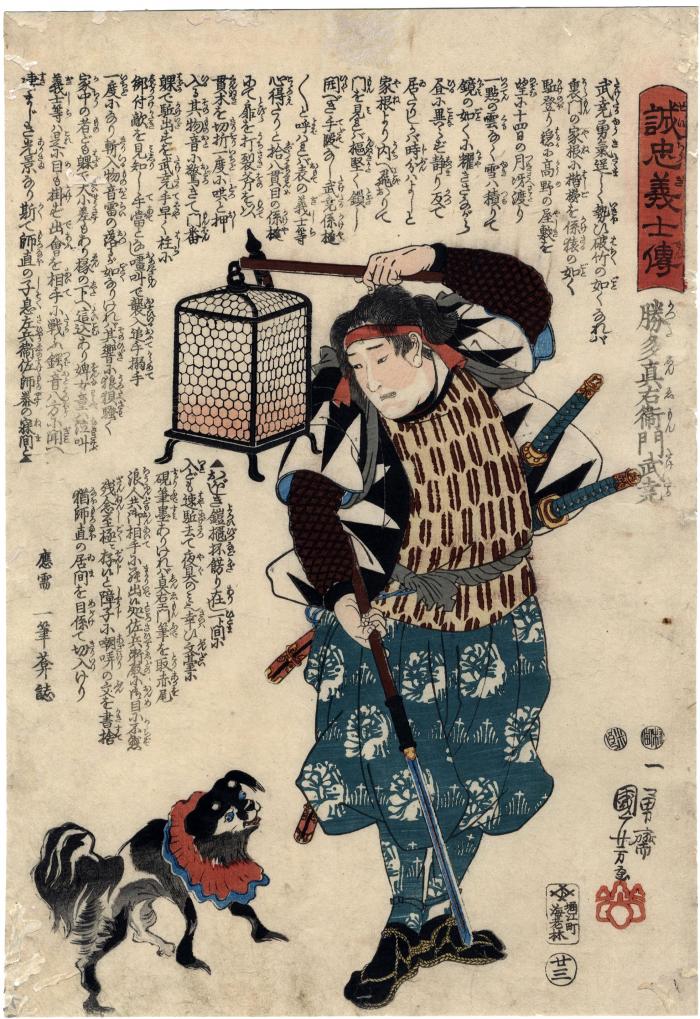Utagawa Kuniyoshi (歌川国芳) (artist 11/15/1797 – 03/05/1861)
No. 23 (廿三): Katsuta Shinzaemon Taketaka (勝多真左衛門武尭) from the series Biographies of Loyal and Righteous Samurai (Seichu gishi den - 誠忠義士傳)
1847
9.75 in x 14 in (Overall dimensions) Japanese woodblock print
Signed: Ichiyūsai Kuniyoshi ga
一勇斎国芳画
Artist's seal: kiri
Publisher: Ebiya Rinnosuke
(Marks 040 - seal not listed)
Censor's seal: Mera and Murata
Number 23: 廿三
British Museum
Museum of Fine Arts, Boston
Waseda University
Tokyo Metropolitan Library
British Museum - another Kuniyoshi print from 1857 devoted to this same character
Museum für Kunst und Gewerbe, Hamburg
Palmer Museum of Art, Penn State University
National Museum of Japanese History (via Ritsumeikan University)
Art Gallery of Greater Victoria
Allentown Museum of Art
Walters Art Museum
Edo-Tokyo Museum
Ako City Museum of History (via Ritsumeikan University)
Palmer Museum of Art, Penn. State
Chiba City Museum of Art There are 51 prints in this series of which 4 are in the Lyon Collection.
****
The dentate pattern on this print is a give away that it is a Chūshingura-themed prints. But not all prints devoted to this story show these designs. "The distinctive dentate pattern on the coats is an iconographical motif which represents the inescapable progress of day and night, symbolizing unfailing loyalty."
Quoted from: 'Mitate kokkei Chūshingura. Hiroshige's humorous parodies of the Loyal Retainers' by Pierre Wijermans and Henk Herwig, fn. 32, p. 73.
****
The text reads:
"武尭勇気逞しく勢ひ破竹の如くなれば 裏門の家根に楷梯を係 猿の如く駈登り穏に高野の屋敷を望に 十四日の月冴渡り一点の雲なく雪は積りて 鏡の如くに輝きさながら昼に異ならず 静り反て居たりしかば 時分はよしと家根より内へ飛おりて 門をみれば樞堅く鎖し開べき手段なし 武尭係槌/\と呼はれば 表の義士等心得たりと 拾八貫目の係槌にて扉を打裂 斧を以貫木を切折一度に哄と押入る 其物音に驚きて門番裸で駈出すを 武尭手早く柱に☆付 敵を見知り手当となし ☆叫で襲入 追手搦手一度になり斬人物音雷の落るが如なりければ 其響に狼狽騒く家中の者ども 裸で大小差もあり縁の下へ這込あり 婢女童は泣叫 義士等は是に目も掛ず出会を相手に戦ふ鍔音 八方に聞へ凄まじき光景なり 斯て師直の子息左兵衛佐師泰の寐間とおぼしき鎧櫃杯餝飾り在し一ト間に入ども 速駈去て夜具のみ也 幸ひ文台に硯筆墨ありければ真右ヱ門筆を取 赤尾浪人共御相手に罷出候処 佐兵衛殿に御目に不懸残念至極ニ存候と 障子に嘲哢の文を書捨 猶師直の居間を目係て切入けり 応需 一筆庵誌"
The author of this text is Ippitsu-an (一筆庵誌).
A crude Google translation is: "When Takeya became brave and strong like a broken bamboo, he set a ladder at the base of the back gate and climbed like a monkey, calmly looking out at the mansion in Takaya. On the 14th, when the moon was shining, there was not a single cloud, and the snow had piled up, shining like a mirror, but it was no different from the daytime, and it was still and quiet, but when I thought the time was right, I flew inward from the roots of the house and looked at the gate. It is tightly chained and there is no way to open it.If you call it Taketaka's mallet, you will know that it is a public servant.The door is broken down with the 18th chain mallet, and the ax is used to cut through the wood at once. They break in. The gatekeeper is startled by the noise and runs out naked. Taketaka quickly attaches it to a pillar. He recognizes the enemy and takes no precautions. He attacks with a scream. His pursuers attack him at once, and the sound of the person being cut is like the sound of thunder. Everyone in the house was making a fuss, naked people of all sizes were crawling under the verandah, girls and children were crying, and the warriors were fighting against each other without paying attention to what was going on.It was a terrifying sight on all sides. So, when Moronao's son Sahei Sashiyasu's living room and a suit of armor and cup decorations were there, he hurried away and found himself in the middle of the night. The Akao ronin and the others were arrested, and they left a mocking message on the shoji door, telling Sahei-dono that they were still alive, and that they were not in the same position. "
****
Illustrated in Kuniyoshi: The Faithful Samurai by David R. Weinberg, Hotei Pubiishing, 2000, #I.23.
****
There is another copy of this print in the Pushkin State Museum.
****
The Museum of Fine Arts in Boston narrow the publication date for this print to between the 7th and 12th month of 1847.
Ebiya Rinnosuke (海老屋林之助) (publisher)
warrior prints (musha-e - 武者絵) (genre)
Chūshingura (忠臣蔵 - 47 Rōnin) (genre)
